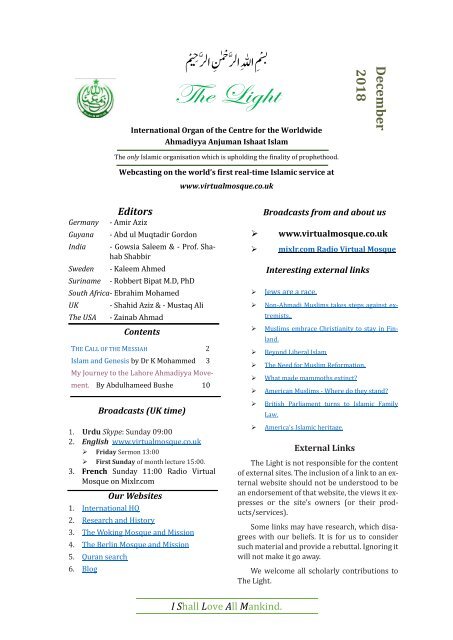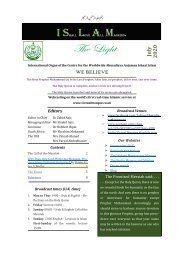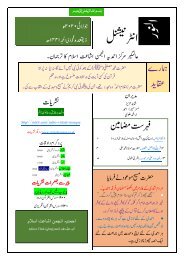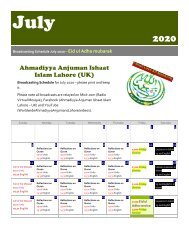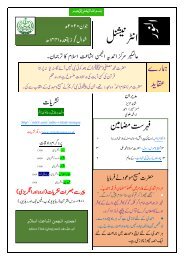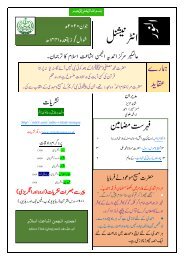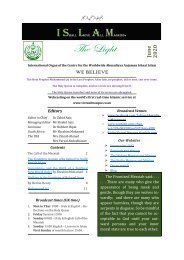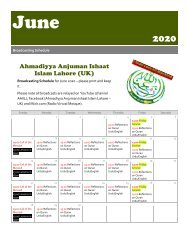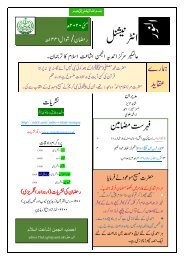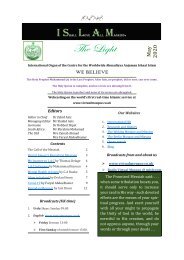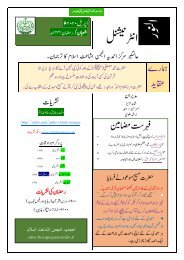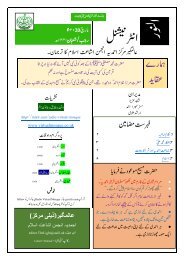The Light December 2018 12
English organ of the Ahmadiyya Anjuman Ishaat Islam of Lahore. Presenting Islam as taught by the Holy Prophet Muhammad (s) as a liberal, tolerant, rational and inclusive religion.
English organ of the Ahmadiyya Anjuman Ishaat Islam of Lahore. Presenting Islam as taught by the Holy Prophet Muhammad (s) as a liberal, tolerant, rational and inclusive religion.
You also want an ePaper? Increase the reach of your titles
YUMPU automatically turns print PDFs into web optimized ePapers that Google loves.
ِ ی م الرَّحم<br />
ن<br />
ِ<br />
سب اہللِ الرَّْحم ٰ<br />
ْ م ِ<br />
<strong>The</strong> <strong>Light</strong><br />
International Organ of the Centre for the Worldwide<br />
Ahmadiyya Anjuman Ishaat Islam<br />
<strong>2018</strong><br />
April<br />
2016<br />
<strong>December</strong><br />
<strong>The</strong> only Islamic organisation which is upholding the finality of prophethood.<br />
Webcasting on the world’s first real-time Islamic service at<br />
www.virtualmosque.co.uk<br />
Germany<br />
Guyana<br />
India<br />
Sweden<br />
Suriname<br />
Editors<br />
- Amir Aziz<br />
- Abd ul Muqtadir Gordon<br />
- Gowsia Saleem & - Prof. Shahab<br />
Shabbir<br />
- Kaleem Ahmed<br />
- Robbert Bipat M.D, PhD<br />
South Africa- Ebrahim Mohamed<br />
UK<br />
<strong>The</strong> USA<br />
- Shahid Aziz & - Mustaq Ali<br />
- Zainab Ahmad<br />
Contents<br />
THE CALL OF THE MESSIAH 2<br />
Islam and Genesis by Dr K Mohammed 3<br />
My Journey to the Lahore Ahmadiyya Movement.<br />
By Abdulhameed Bushe 10<br />
Broadcasts (UK time)<br />
1. Urdu Skype: Sunday 09:00<br />
2. English www.virtualmosque.co.uk<br />
‣ Friday Sermon 13:00<br />
‣ First Sunday of month lecture 15:00.<br />
3. French Sunday 11:00 Radio Virtual<br />
Mosque on Mixlr.com<br />
Our Websites<br />
1. International HQ<br />
2. Research and History<br />
3. <strong>The</strong> Woking Mosque and Mission<br />
4. <strong>The</strong> Berlin Mosque and Mission<br />
5. Quran search<br />
6. Blog<br />
Broadcasts from and about us<br />
‣ www.virtualmosque.co.uk<br />
‣ mixlr.com Radio Virtual Mosque<br />
Interesting external links<br />
‣ Jews are a race.<br />
‣ Non-Ahmadi Muslims takes steps against extremists..<br />
‣ Muslims embrace Christianity to stay in Finland.<br />
‣ Beyond Liberal Islam<br />
‣ <strong>The</strong> Need for Muslim Reformation.<br />
‣ What made mammoths extinct?<br />
‣ American Muslims - Where do they stand?<br />
‣ British Parliament turns to Islamic Family<br />
Law.<br />
‣ America's Islamic heritage.<br />
External Links<br />
<strong>The</strong> <strong>Light</strong> is not responsible for the content<br />
of external sites. <strong>The</strong> inclusion of a link to an external<br />
website should not be understood to be<br />
an endorsement of that website, the views it expresses<br />
or the site's owners (or their products/services).<br />
Some links may have research, which disagrees<br />
with our beliefs. It is for us to consider<br />
such material and provide a rebuttal. Ignoring it<br />
will not make it go away.<br />
We welcome all scholarly contributions to<br />
<strong>The</strong> <strong>Light</strong>.<br />
I Shall Love All Mankind.
ۚ<br />
October <strong>2018</strong> <strong>The</strong><br />
<strong>Light</strong> 2<br />
<strong>The</strong> Call of the<br />
Messiah<br />
by Hazrat Mirza Ghulam<br />
Ahmad<br />
<strong>The</strong> Promised Messiah and Mahdi<br />
(Editor’s note: Any quotations from the Quran<br />
are translated from the author’s explanations<br />
and are not literal translations of the verse<br />
quoted. This extract is from the English translation<br />
of a lecture he delivered in 1904 in Lahore,<br />
now in Pakistan, taken from the Lahore Ahmadiyya<br />
publication ‘Essence of Islam’, p. 66 – 71)<br />
Signs of the Latter Age<br />
Some men think that the prophecy relating<br />
to the appearance of the Promise is contained<br />
only in the traditions (Hadith) and not in the<br />
Holy Quan, and accordingly they demand a<br />
proof of it from the Word of God.<br />
A reflection upon the words of the Holy<br />
Book is sufficient to convince any reasonable<br />
man that this prophecy is contained in the<br />
plainest words in the Holy Quran. In the chapter<br />
entitled the Tahrim, it is indicated that some individuals<br />
from among the Muslims would be<br />
called ibn-i-Maryam (the Son of Mary). In that<br />
chapter at first the faithful are compared to<br />
Mary and afterwards the breathing of a soul into<br />
her (i.e., the faithful like her) is mentioned. This<br />
indicates that the faithful who observe complete<br />
obedience to Divine commandments, and<br />
make themselves like Mary, will be rewarded by<br />
God by being made Christ like. It is in reference<br />
to the attainment of this stage that Almighty<br />
God says of me in a revelation published in the<br />
یا مریم امکن انت و زوجک الجنۃ Ahmadiyya: Barahin<br />
“O Mary! Enter paradise, you with your friends”.<br />
And again: یا مریم نفخت فیک من روح بالصدق O“ Mary!<br />
I have breathed into you the soul of truth,” (thus<br />
symbolically Mary was impregnated with the<br />
إِذْ قَالَ ٱَّلله ُ ٰٓ یَعِیسَى إِنِى مُتَوَ فِیكَ all: truth); and last of<br />
nat- “O Jesus! I will cause you to die a اِلَ هى<br />
ural death and would then raise you to Myself,”<br />
where I am addressed as Jesus Christ as if raised<br />
from the dignity of Mary to the dignity of Christ.<br />
Thus, the promise contained in the chapter Tahrim<br />
has been fulfilled in me, and l am named by<br />
God as the son of Mary.<br />
Again, in the chapter. entitled the Nur<br />
(<strong>Light</strong>), Almighty God says that successors to<br />
the Holy Prophet would be raised from among<br />
the Muslims resembling all the successors that<br />
السْتَخْلِفَنههُمْ فِى were raised to Moses as in the verse<br />
َك وَ رَ افِعُ<br />
I Shall Love All Mankind.<br />
From the Holy Quran ٱْلْ َرْ ضِ كَمَا ٱسْتَخْلَفَ ٱلهذِینَ مِن قَبْلِهِمْ<br />
it also appears that the religion of Islam would<br />
witness two terrible disasters which would endanger<br />
its very life. One of these came upon Islam<br />
with the death of the Holy Prophet and was<br />
averted at the hands of Abu Bakr, the first caliph<br />
according to the Divine promise. <strong>The</strong> second<br />
disaster according to the Holy Quran would be<br />
the evil that would be wrought by the Anti-<br />
Christ, to repel which the Promised Messiah<br />
would appear. It is to this great evil that the concluding<br />
words of the Fatiha, which every Muslim<br />
must repeat in his prayers, allude. It is to<br />
this time of tribulation that the prophecy con-<br />
وَ لَیُمَكِنَنه لَهُمْ دِینَهُمُ ٱلهذِى ٱرْ تَضَى لَهُ ْم words: tained in the<br />
refer which occur in Nur وَ لَیُبَدِلَنههُم مِنۢ بَعْدِ خَوْ فِهِمْ أَمْنًۭا<br />
immediately after the words in which successors<br />
to the Holy Prophet are promised (<strong>The</strong><br />
Holy Quran 24:55).<br />
In these words, Almighty God tells us that in<br />
the last ages when the faith of Islam would be<br />
severely shaken, so much so that there would be<br />
fear of its extinction and of its being swept off<br />
wholly, He would re-establish it with firmness<br />
upon the earth, and grant the Muslims a security<br />
after that great fear. To the same effect the<br />
هُوَ ٱلهذِىٰٓ أَرْ سَلَ رَ سُولَهُ ۥ elsewhere: Holy Quran says<br />
بِٱلْهُدَى وَ دِینِ ِ ٱلْحَق لِیُظْهِرَ ۥهُ عَلَى ٱلدِینِ كُلِهِۦ وَ لَوْ كَرِ هَ ٱلْمُشْرِ كُو َن<br />
“God is He Who sent His messenger with the<br />
guidance and the true faith so that He may ultimately<br />
(i.e., in the time of the Promised Messiah)<br />
make it victorious over all other religions”<br />
ۥ (9:33). Again, the verse<br />
Qur’an, “Verily We sent down the Holy لَحَفِظُونَ<br />
and verily We will be its guardians,” (15: 9) also<br />
refers to the time of the Promised Messiah. As it<br />
speaks of the sending down of revelation which<br />
was affected through the Holy Prophet, it also<br />
speaks of guarding the revealed word from its<br />
enemies when it would be in danger of being<br />
brought to extinction, which is the function of<br />
the Promised Messiah. Here, I have briefly<br />
pointed out the verses in which the advent of<br />
the Promised Messiah is indicated, either in<br />
plain words or by alluding to it. A detailed proof<br />
would not have suited the limits of a lecture.<br />
This is sufficient proof for anyone seeking evidence<br />
of my claim in the Holy Quran in the same<br />
manner in which he seeks an evidence of the<br />
claim of the Holy Prophet or Jesus Christ in the<br />
previous books. So, if these prophecies are not<br />
regarded as sufficient, it must also be admitted<br />
that there is no prophecy in the Torah concerning<br />
the appearance of Jesus or our Holy Prophet,<br />
for if the words of the former prophecies are not<br />
إِنها نَحْنُ نَزه لْنَا ٱلذِكْرَ وَ إِنها لَهُ
October <strong>2018</strong> <strong>The</strong><br />
<strong>Light</strong> 3<br />
very definite, neither are they so in the case of<br />
the latter prophecies. It is exactly here that the<br />
Jews stumbled in the recognition of the two<br />
prophets, Jesus and Muhammad, may peace and<br />
the blessings of God be upon them. For instance,<br />
if it had been stated in plain and clear words in<br />
the prophecies foretelling the appearance of<br />
our Holy Prophet that he would be born at<br />
Mecca, that his name would be Muhammad,<br />
that his father and grand-father would be<br />
known respectively as Abdullah and Abdul Muttalib,<br />
that he would be of the Ishmaelite race,<br />
that being persecuted at Mecca he would fly to<br />
Medina, and that he would be born so many<br />
years after Moses, not a single Jew could have<br />
denied him.<br />
<strong>The</strong> difficulties in the case of the prophecies<br />
relating to the appearance of Jesus Christ are<br />
still greater, and it is on this ground that the<br />
Jews to this day consider themselves excusable<br />
in rejecting Jesus. In these prophecies, it is<br />
clearly stated that Elijah would re-appear before<br />
the advent of the true Messiah and prophecies<br />
containing this condition are contained in<br />
the revealed books. But since Elijah did not reappear,<br />
therefore the claim of Jesus to Messiahship<br />
could not be regarded as true by the Jews.<br />
When confronted with this difficulty, Jesus replied<br />
that by appearance of Elijah was meant<br />
the appearance of one like him, and not his own<br />
appearance. But this explanation was rejected<br />
by the Jews as directly opposed to the Word of<br />
God which spoke not of the advent of the like of<br />
Elijah, but of the advent of Elijah himself. <strong>The</strong>se<br />
considerations show clearly that the prophecies<br />
relating to the appearance of the prophets of<br />
God are always deep so that they may serve to<br />
distinguish the righteous from the wicked. (Return<br />
to contents)<br />
Islam and Genesis<br />
A Study in Scriptural Intertextuality<br />
by Khaleel Mohammed<br />
Department of Religious<br />
Studies,<br />
San Diego State University<br />
Abstract: Abraham Geiger’s 1833 essay<br />
launched a genre of research that posits foreign<br />
etymology for many terms in the Quran.<br />
Whereas some work has been erudite, others<br />
I Shall Love All Mankind.<br />
have posited far-fetched concepts to the point<br />
where at least one author opines that Aramaic<br />
was the original language of the Quran. Muslim<br />
exegetes have compounded the problem by<br />
seeking to interpret the Quran on its own, without<br />
reference to other Abrahamic scriptures. I<br />
argue that Muhammad’s (s) audience understood<br />
him clearly since he was using terms that<br />
had become part of the Arabic language long before<br />
his time. I examine three terms: islam,<br />
iman, and din, showing that the meaning of<br />
these words in the Quran can be deciphered by<br />
reliance on context of usage and intertextuality.<br />
To this end, I refer to several verses of the Quran<br />
as well as of the Hebrew Bible and Talmudic literature.<br />
A proper understanding of these words<br />
allows us to see Q3:19 and Q5:3 as pluralistic<br />
instead of the particularistic interpretation that<br />
most exegetes proffer.<br />
Abraham Geiger’s 1833 essay Was hat Muhammad<br />
aus dem Judenthume aufgenommen<br />
postulated that the Quran was largely unoriginal:<br />
Muhammad (s) had compiled it using at<br />
least 14 terms from the Hebrew Bible and rabbinic<br />
literature, in addition to several other Jewish<br />
concepts (Geiger 1970, p. 44). Later analysis<br />
revealed that his work was “naï ve and judgmental”<br />
(Lassner 1999), and that he sometimes fell<br />
victim to parallel-mania, positing Quranic borrowings<br />
from Pirke De-Rabbi Eliezer without<br />
realizing that the latter document was composed<br />
after the advent of Islam (Stillman 1974).<br />
Yet, Geiger must be hailed as the pioneer of the<br />
quest for foreign provenance of Quranic terms.<br />
His work set off a torrent of publications by Jewish<br />
scholars who sought to further detail Judaic<br />
influences on Islam. Hartwig Hirschfeld<br />
(Hirschfeld 1878), for example, wrote Judische<br />
Elemente im Qoran (1878), Charles Torrey<br />
penned <strong>The</strong> Jewish Foundations of Islam<br />
(1933), and Abraham Katsh authored Judaism<br />
and the Koran (Katsh 1954). By the 1870s,<br />
scholars began to oppose some aspects of Geiger’s<br />
claims. Adolph Harnack (d. 1930) surmised<br />
influence from a gnostic Jewish-Christian<br />
community (see Pfanmuller 1923, p. 108). Julius<br />
Wellhausen (d. 1918), after careful analysis,<br />
suggested that Jewish concepts may have entered<br />
Islam through Christian refraction (Wellhausen<br />
1961, p. 205).<br />
This search for foreign provenance continues<br />
to this day, and while engendering some<br />
truly erudite scholarship, has also spawned<br />
some of the most ridiculous claims. One professor,<br />
for example, would have us assume that his
October <strong>2018</strong> <strong>The</strong><br />
<strong>Light</strong> 4<br />
Arabic skills are such that he can correct the text<br />
to “the form the word or phrase had when it was<br />
first uttered by the prophet Muhammad” (Bellamy<br />
1993). Christoph Luxenberg<br />
claims that Muhammad<br />
(s) did not even speak Arabic,<br />
but rather an Arabic-Aramaic<br />
hybrid, and that the Quran is<br />
derived from Syriac Christian<br />
liturgy (Luxenberg 2000).<br />
Another writer tells us that<br />
contrary to what Muslims and historians have<br />
claimed, the Quran was written in Aramaic<br />
(Sawma 2006).<br />
Professor Walid Saleh’s words aptly describe<br />
the situation:<br />
“<strong>The</strong> rule is presented differently by different<br />
scholars, but in a nutshell, it states that for<br />
every word in the Quran for which the native<br />
philological tradition fails to give a solitary explanation<br />
and instead offers multiple meanings,<br />
modern scholars have to presume that they are<br />
dealing with a foreign word. Having determined<br />
that a word in the Quran is foreign, scholars<br />
have gone ahead and presumed that its meaning<br />
in a cognate language or in its purported<br />
language of origin was the determining factor,<br />
and not its usage in its Quranic context.” (Saleh<br />
2010, pp. 649–98)<br />
Working off Professor Saleh’s findings, I intend<br />
to show that three important terms: Islam,<br />
iman, and din were part of the Arabic vocabulary<br />
long before Muhammad’s (s) time, and that<br />
his audience had no problems comprehending<br />
their meaning. I will also show that Islam actually<br />
owes its name to a particular Arabic rendering<br />
of Genesis 17:1. If I can sustain that line of<br />
reasoning for Arabic usage, rather than a foreign<br />
provenance, I demonstrate that two verses<br />
of the Quran (Q3:19 and 5:3) allow for a pluralistic<br />
outlook rather than the particularistic interpretation<br />
that the majority of exegetes have<br />
offered. Each word is of such importance that it<br />
merits a full-length journal article or monograph.<br />
Fortunately, several scholars have written<br />
on the subject, and I use their findings to<br />
make my presentation more concise. I omit the<br />
use of diacritical marks except in cases where I<br />
assume—somewhat arbitrarily—there is an absolute<br />
need for pronunciational accuracy. In<br />
certain cases, I will abbreviate Quran to Q followed<br />
by the chapter and verse number. For example,<br />
Q2:15 indicates the second su ra, verse<br />
15.<br />
Muhammad’s (s) audience<br />
understood him clearly since<br />
he was using terms that had<br />
become part of the Arabic<br />
language long before his time.<br />
I Shall Love All Mankind.<br />
<strong>The</strong> underlying message behind the borrowing<br />
idea seems to indicate that the Quran<br />
has misleadingly depicted its ideas as original,<br />
and that such a claim has<br />
been debunked by the revelations<br />
of its alleged sources.<br />
However, the Quran makes no<br />
secret that its material is not<br />
new; indeed, Muhammad’s<br />
(s) detractors repeatedly described<br />
his narratives as “tales<br />
of the ancients” (Q6:25, 8:31, 16:24, 23:83,<br />
25:5, 27:68, 46:17, 68:15, and 83:13), and he<br />
himself said that he had not come with any innovation<br />
(Q 46:9). <strong>The</strong> Quran also describes itself<br />
as a preserver of the antecedent Abrahamic<br />
scriptures, even advising people to ask the Jewish<br />
mazkirim about matters relating to the<br />
prophets (Q 16:43; 21:7; Mohammed 2015, pp.<br />
33–46). Even if there are perceived differences<br />
in narratives, to assume that we can trace the<br />
“true” story to some urtext is problematic, given<br />
the presence of the two Torot (written and<br />
oral). <strong>The</strong>re was a wide variety of exegetical traditions<br />
that, over a long period of time, “supplemented,<br />
supported, amended, and even perhaps<br />
at times, subverted that legacy” (Pregill<br />
2007, pp. 643–59). If we cannot trace the source<br />
for a reference, it may simply be that, as Marilyn<br />
Waldman noted, the Quran is using the outlines<br />
of a story as a didactic vehicle. (Waldman 1985,<br />
pp. 1–13).<br />
Insofar as language is concerned, some<br />
Western scholars seem reluctant to believe that,<br />
before the Quran, Arabs could effectively communicate<br />
via a language of their own. As Afnan<br />
Fatani notes:<br />
“Arabic is not looked upon not as a sister or<br />
equal language of Hebrew, Aramaic, and other<br />
Semitic languages, i.e., when it is treated as an<br />
offspring that presented the original language<br />
in a degenerated form. It is this view that compels<br />
some Western scholars to constantly look<br />
for the etymology of Quranic terms in other Semitic<br />
languages, convinced that Arabic must by<br />
necessity, have borrowed its lexicon from these<br />
older and more sophisticated languages”. (Fatani<br />
2006, pp. 356–71)<br />
Muslim exegetes added to the problem in<br />
several aspects. One was by relying upon<br />
creedal constructs to provide explanations of<br />
the terms, often engaging in semantic acrobatics<br />
to support their interpretations. <strong>The</strong> earliest<br />
exegetes whose works are available were writing<br />
in a milieu that was far removed from the
October <strong>2018</strong> <strong>The</strong><br />
<strong>Light</strong> 5<br />
one to which the Quran was initially addressed,<br />
operating under constructs that often worked<br />
to their epistemological detriment. Early Muslim<br />
approaches to philology and etymology<br />
were clearly in the service of religion, and this<br />
came with several drawbacks (Kopf 1956, pp.<br />
33–59). While earlier exegetes recognized the<br />
existence of loan words in the Quran, later ones<br />
sought to literally interpret the Quranic verses<br />
that referred to the document being in clear Arabic<br />
(e.g., Q <strong>12</strong>:2, 16:103, 26:195, 41:44, and<br />
42:7). <strong>The</strong> derived reasoning was that since God<br />
cannot lie, then every word had literally to be<br />
from an Arabic source.<br />
Another problematic concept was the widespread<br />
Muslim contention that the previous<br />
scriptures were corrupted and therefore not reliable.<br />
This is underlined by the idea that reliance<br />
upon rejecting Judaic traditions—known<br />
as israiliyat—would lead to false interpretations<br />
(Mohammed 2015, p. 15). Rejecting biblical<br />
influence negatively affected exegesis, given<br />
that, as Reuven Firestone aptly noted, “the<br />
Quran could not possibly exist without its scriptural<br />
predecessors as subtexts” (Firestone<br />
2004, pp. 1–22). <strong>The</strong> dynamic influence that the<br />
Quran has had upon the Arabic language has<br />
also exacerbated the problem. This is because<br />
almost every classical dictionary of Arabic relies<br />
heavily on the Quran for elucidation, often<br />
without regard to differences between terminological<br />
and quotidian usage.<br />
I rely on some late discoveries within the<br />
field of Islamic studies to form certain relevant<br />
premises. <strong>The</strong> recent discovery of what some<br />
term as the Birmingham manuscript basically<br />
vouchsafes what the Muslim tradition has always<br />
held: that the Quran goes back to the time<br />
of Muhammad (s), unlike the late dating that researchers<br />
have claimed, such as Patricia Crone,<br />
Michael Cook, and John Wansbrough, for example.<br />
<strong>The</strong> presence of Christian and Jewish tribes<br />
in the Arab peninsula long before Muhammad’s<br />
(s) birth meant that, cognate consideration<br />
aside, certain religious concepts, even if they<br />
had stemmed from foreign terminology, had become<br />
completely Arabized by Muhammad’s (s)<br />
time (Griffith 2013; Gilliot and Larcher 2001).<br />
<strong>The</strong>re is also a midrash dated to the second or<br />
third century Sifre to Deuteronomy 32:2 that<br />
states, “When God revealed Himself to give the<br />
Torah to Israel, He did so not in one language,<br />
but in four: in Hebrew, in Greek, in Arabic, and<br />
in Aramaic” (Goitein 1958, pp. 149–63). As<br />
Goitein astutely pointed out, whereas such<br />
I Shall Love All Mankind.<br />
Insofar as language is concerned,<br />
some Western scholars seem reluctant<br />
to believe that, before the<br />
Quran, Arabs could effectively<br />
communicate via a language of<br />
their own.<br />
translation was probably never committed to<br />
writing, it certainly must have been present via<br />
an oral method. <strong>The</strong> Arabs were therefore not<br />
as unfamiliar with Biblical material as the proponents<br />
of the foreign etymology camp might<br />
suppose.<br />
Let us examine the first of the three terms:<br />
Islam. It is derived from the fourth form (أسلم) of<br />
the verb سلم (salima), which occurs in the Quran<br />
in its various forms some 157 times. <strong>The</strong> verb<br />
forms of أسلم occur 22 times, and the noun, Islam,<br />
from that verb, is found in eight verses. <strong>The</strong><br />
meanings of various verb forms of a common<br />
root in Arabic can seem unrelated to each other.<br />
<strong>The</strong> second form of salima, for example, sallama,<br />
used transitively, means to hand over or<br />
to give over something. Used with a preposition,<br />
it means to greet, as in Sallama alaihi. One must<br />
avoid arbitrarily selecting a meaning from any<br />
particular root simply because it fulfils a cherished<br />
objective; an offered explanation should<br />
be accompanied by incontrovertible proof(s).<br />
Jane Smith, in her 1975 doctoral dissertation,<br />
noted that, “[W]ithin the Muslim community<br />
itself, there has been a change in the understanding<br />
and interpretation of Islam, i.e., that<br />
the word connotes to Muslims of the current<br />
century something different (or additional to)<br />
what it meant to those of the early centuries of<br />
Islam” (Smith 1975, pp. 2–3). After 9/11, some<br />
Muslim apologists, trying to distance their faith<br />
from the stereotype of violence, tried to focus<br />
on one derivative of Salima (as opposed to its<br />
fourth form, aslama) to insist that Islam comes<br />
from the word ‘salam’ and means peace (see for<br />
example, Balogun 2014). Our task then is specific:<br />
it is not to simply look for the root, but to<br />
examine the word’s usage and if possible, refer<br />
to a narrative or concept already known to the<br />
Arabs.<br />
Several lexicons provide a gamut of meanings,<br />
including “safety” as well as “freedom from<br />
blemish,” but end up referring to the Quran to<br />
proffer Islam as submission (khudu) or accepting<br />
what the Prophet has brought (Al-Jawhari<br />
1957; Al-Isfahani 1961, pp. 240–1; Ibn Manz u r
October <strong>2018</strong> <strong>The</strong><br />
<strong>Light</strong> 6<br />
n.d., pp. 342–50). Ismail al-Jawhari (d.c. 400), in<br />
his Taj al-Lugha, deduced that the Aslama and<br />
istaslama forms are contextually equivalent and<br />
therefore underlined the meaning as “submission”<br />
(1957). <strong>The</strong> general trend in the tafsirs is<br />
not different, as noted in Jane Smith’s study of<br />
14 major exegetes, to represent the explanation<br />
over a 14-century period (Smith 1975, pp. 218–<br />
26). Interestingly, she cites al-Razi who, among<br />
other definitions, offered that the term means<br />
“entering into wholeness or peacefulness”—<br />
this of course being achieved by subjecting oneself<br />
to the obligations required by God (Al-Razi,<br />
vol. 7, p. 702).<br />
Some Western-based analyses have offered<br />
truly far-fetched interpretations. Margoliouth<br />
asserted that the derived word “Muslim” has little<br />
to do with the Arabic root to which it is usually<br />
traced, but that it was instead derived from<br />
the name Musailima, the false prophet of a monotheistic<br />
sect (Margoliouth 1903, pp. 467–83).<br />
Mark Lidzbarski debunked Margoliouth’s allegation,<br />
and then, following the borrowing concept,<br />
alleged that the word has no meaning on<br />
its own, but can be traced to be like the Greek<br />
σωτηια (soteria), indicating salvation (Lidzbarski<br />
1922, pp. 85–96). Meir Bravman decided<br />
that none of these explanations was convincing<br />
and related the term to “gihād”, rendering it as<br />
“defiance of death, self-sacrifice (for the sake of<br />
God and his prophet), or “readiness for the defiance<br />
of death” (Bravmann 2009, pp. 1–38).<br />
Both David Kuntslinger and Helmer Ringgren<br />
examined Hebrew and Aramaic cognates of the<br />
word, with the former pointing out that some<br />
שלום usages in the Quran match the Hebrew<br />
(Ku ntslinger 1935, pp. <strong>12</strong>8–37). Ringgren refers<br />
to various parts of Quran and verses of ancient<br />
poetry to show<br />
that, while he opted for a<br />
general meaning of submission<br />
and surrender,<br />
there are other usages<br />
(Ringgren 1949, pp. 1–<br />
27). Q2:66, for example,<br />
“mussalamatun la<br />
shīyata fihā”, indicates a<br />
heifer that is perfect and<br />
free from blemish. In<br />
Q37:82 and 26:89, he also points out that it<br />
means “sound” as in Qalb Salīm (1949). He drew<br />
upon Isaiah 38:3 to show an almost identical expression<br />
ם) (שלֵ֔ that in context means “whole<br />
and undivided” (Ringgren 1949). Incidentally,<br />
the Quran 2:135 revisits the argument<br />
that Jews and Christians have engaged<br />
in over the identity of Abraham with,<br />
“<strong>The</strong>y say, ‘Be Jews or Christians, and<br />
you will be guided.’ Say ‘Rather the path<br />
of Abraham, a hanif; he was not one of<br />
the polytheists.”<br />
I Shall Love All Mankind.<br />
in Arabic parsing, the term “sālim” is used to denote<br />
a noun (or its plural form), which is<br />
“sound”, i.e., adhering to all the qualities of a<br />
noun, as in the word “Qā’ilūn”, wherein the form<br />
of the plural suffix indicates that it is a sound<br />
masculine plural: “jamʽ mudhakkar sālim” (Ibn<br />
Hisha m 2003).<br />
<strong>The</strong> background that Ringgren and<br />
Kuntslinger provided is certainly useful, but<br />
when examining both the Hebrew and Arabic<br />
cognates, they seemed to overlook certain simple<br />
facts. <strong>The</strong> first is that the Quran occasionally<br />
reports Biblical stories with its own—obviously<br />
Arabic—rendition of the actual dialogue. <strong>The</strong><br />
second is that, in the Arabian environment, as<br />
noted earlier in Sifre midrash to Deuteronomy<br />
32:2, there is evidence that there were at least<br />
partial translations of the Torah in Arabic. Most<br />
likely, such translations would have originated<br />
too from the Aramaic Targum rather than the<br />
Hebrew text. <strong>The</strong> third is that, in the Quran,<br />
Abraham is the prototype of the perfect worshipper.<br />
Indeed, the Quran 2:135 revisits the argument<br />
that Jews and Christians have engaged<br />
in over the identity of Abraham with, “<strong>The</strong>y say,<br />
‘Be Jews or Christians, and you will be guided.’<br />
Say ‘Rather the path of Abraham, a hanif; he was<br />
not one of the polytheists.” <strong>The</strong> Quran 2:<strong>12</strong>8<br />
also has Abraham and Ishmael laying the foundations<br />
of the Kaaba in Mecca and asking God<br />
that they be Muslim.<br />
Charles Torrey pointed out that Muhammad<br />
(s) did not consider Islam as a new religion<br />
(Torrey 1967, p. 64), referring to the identification<br />
of Abraham in the Quran, not only as Muslim,<br />
but exhorting his offspring to be such (Q<br />
2:132). Rather strangely, Torrey makes no mention<br />
of verse Q2:131. He then states that there<br />
was no real equivalent<br />
in Aramaic or Syriac<br />
(Torrey 1967, p. 101),<br />
and as such, he attributed<br />
the word to a<br />
genuine Arabic usage.<br />
While disputing the interpretation<br />
of “submission”,<br />
he offers the<br />
meaning of “yielding to<br />
the will of God.” This is<br />
where Q2:131 becomes so important to us: Idh<br />
qāla lahū Rabbuhū “Aslim.” Qāla, “Aslamto li rabbil<br />
alamīn.” <strong>The</strong> Quran is obviously referring to<br />
Genesis 17.1, wherein the partly-translated text<br />
reads, “When Abram was ninety-nine years old,<br />
<strong>The</strong> Lord appeared before him and said I am
ڼک<br />
October <strong>2018</strong> <strong>The</strong><br />
<strong>Light</strong> 7<br />
תָ ִֽמים God Almighty. Walk before me and be<br />
(tamīm).” <strong>The</strong> various translators have rendered<br />
תָ ִֽמים differently: some as “blameless”,<br />
others as “whole-hearted.” While there is agreement<br />
that in order to obey God’s edicts, one<br />
must submit, the word in context has no direct<br />
connotation of submission; rather, it indicates<br />
the attempt to be perfect, to be without blemish,<br />
to be sincere and loyal. <strong>The</strong> Arabic contextual<br />
rendition, working off the Hebrew cognate,<br />
أتمم (Kun tamāman) or تماما would be either<br />
(atmim). Since the Arabs were more familiar<br />
with the Aramaic Targum, the more significant<br />
שְׁ ל ים word, as in Onkelos, would have been<br />
(shalīm). It is rather noteworthy that תָָּ֧ ם (tam)<br />
of the Hebrew Bible is generally rendered as<br />
1:1, except in a few cases, such as in Job ,שְׁ ל ים<br />
where it becomes ללא מום (without blemish).<br />
If we are to accept the Midrash in Sifre, as<br />
earlier mentioned, the Arabic version would<br />
seem to be more obviously related to the Aramaic<br />
cognate rather than the Hebrew ִֽמים .תָ <strong>The</strong><br />
effective translation then of Q 2:131 is: “His<br />
Lord said to him; ‘Be whole (without blemish)’.<br />
He responded, ‘I will (seek to) be whole/without<br />
blemish for the Lord of the Worlds.’” Since<br />
the Quran summarizes the entire episode, it<br />
subsumes the rest of the Genesis narrative in<br />
Q2:132: Abraham bequeathed unto his offspring,<br />
as did Jacob, “O our children. God has<br />
purified for you the din; do not die unless you<br />
are in a state of being without blemish.” Being<br />
whole or without blemish, in context, would be<br />
only achievable by following God’s edicts. This<br />
is underlined by the references already made,<br />
for example to Abraham approaching his lord<br />
“bi Qalbin Salīm”—a perfect heart (Q37:82).<br />
What the Quran has effectively done then, is to<br />
simply use a word that would have been known<br />
to the Arabs with the presence of Jewish and<br />
Christian tribes. I have no reason as to why<br />
Western-based researchers have overlooked<br />
Q2:131. It is obvious, however, that in so doing,<br />
they missed the element of understanding the<br />
term Islam.<br />
Jane Smith focused on how Muslim exegetes<br />
interpreted the term. Since their discussion, as<br />
noted earlier, focused upon the term solely from<br />
an Arabic linguistic perspective and creedal<br />
foundations, they largely opted for a meaning of<br />
submission. Relying upon the general use of the<br />
word from the root salima, Ringgren noted that<br />
it would appear that the general meaning is one<br />
of “wholeness, entirety, or totality . . . something<br />
that is whole, unbroken, and undivided and<br />
I Shall Love All Mankind.<br />
This lessening of standards was<br />
not accepted by everyone, and<br />
thus a more appropriate nomenclature<br />
was sought for those<br />
who did not merit the designation<br />
of mumin; “muslim” seems<br />
to have been the appropriate<br />
choice<br />
therefore sound and healthy, or peaceful and<br />
harmonious” (Ringgren 1949, pp. 1–35). Surprisingly,<br />
he still opted for a meaning of submission.<br />
Given the milieu to which Muhammad (s)<br />
arrived, it would seem unlikely that Muhammad<br />
(s) would have chosen a term that has the concept<br />
of submission as its primary meaning,<br />
since the polytheist gods also demanded submission<br />
(Baneth 2001, pp. 85–92). Abraham, as<br />
portrayed in Genesis, while subjecting himself<br />
to God’s commands, is not an example of abject<br />
submission: he questions and reasons with God.<br />
Were the primary meaning to be submission,<br />
the word would most likely have been istislam,<br />
and that would not have been sourced to Genesis<br />
17:1. A derived noun from istislam, mustaslimūn,<br />
occurs as a hapax legomenon in 37:26,<br />
where the connotation is clearly one of abject<br />
submission, describing the condition of the contumacious<br />
folk who, having mocked the concept<br />
of a day of reckoning, would now be gathered<br />
for sentencing.<br />
<strong>The</strong> long discourse on the meaning of Islam<br />
does not contain much reference to Muslim exegetes<br />
who—at least the ones whose works I<br />
have examined—did not try to find the Hebrew<br />
Bible reference of Q2:131 to buttress their explanations.<br />
Since it is clear then that the Quran<br />
was working off a Biblical reference for its coinage,<br />
this segues into the discussion about iman,<br />
that I, as do most other researchers on the subject,<br />
translate as “faith” or “belief”.<br />
Q49:14 makes a clear distinction between<br />
Islam and iman: the bedu Arabs say, “We have<br />
believed!” Say, “You have not believed; say rather,<br />
‘we have professed Islam,’ for faith has not<br />
entered your hearts.” Abdul Khaliq Kazi (1966)<br />
and Jane Smith (1975) excellently investigated<br />
the terms to the point where a summary of their<br />
findings will suffice for our purposes. <strong>The</strong> Muslim<br />
savants of the second and third hijri centuries<br />
debated over what removed a person from<br />
being considered a “mumin” (believer). <strong>The</strong>
October <strong>2018</strong> <strong>The</strong><br />
<strong>Light</strong> 8<br />
Khawarij, Mutazilites, and Shias set the most<br />
rigid standards, insisting that iman was basically<br />
belief professed by the tongue and felt in<br />
the heart, and manifested in abstinence from<br />
sin—although they differed regarding the extent<br />
of the sin that would expel someone from<br />
being a mumin (Kazi 1966, pp. 227–37). With<br />
the spread of Asharite theology, iman was<br />
deemed as restricted to belief, and not necessarily<br />
manifested in conduct (Kazi 1966, pp.<br />
227–37). This lessening of standards was not<br />
accepted by everyone, and thus a more appropriate<br />
nomenclature was sought for those who<br />
did not merit the designation of mumin; “muslim”<br />
seems to have been the appropriate choice.<br />
By the end of the Umayyad period (circa 750),<br />
the scholars had identified Islam as the religion<br />
of the Arabs, and “Muslim” as the designation<br />
for the followers of this religion (McAuliffe and<br />
Clare 2001, pp. 398–417).<br />
Abu Hanifa, in differentiating between Islam<br />
and iman, considered the former term as indicating<br />
submission and subjection and the latter<br />
denoting confirmation and belief; yet, he<br />
noted that one was not possible without the<br />
other (Kazi 1966, pp. 227–37). By the sixth century<br />
hijri, Al-Shahristani (d. 548/1158) had<br />
come up with what is now accepted as the majoritarian<br />
view: Islam denotes outward submission,<br />
and both a mumin and a hypocrite (Al-<br />
Shahristani 1910, pp. 53–54) can practice it. A<br />
mu’min, from this outlook, denotes one who<br />
sincerely believes, and who acts according to<br />
the dictates of the faith.<br />
Jane Smith examined the two terms in the<br />
14 hadiths and concluded that there is a clear<br />
line of demarcation drawn between Islam and<br />
iman. Islam consists of performing five specific<br />
rituals (shahādah, ṣalāt, zakāt, ṣawm, and ḥajj),<br />
whereas iman is faith in various elements that<br />
are mentioned in the Quran and traditional literature,<br />
such as God, the messengers, Muhammad<br />
(s), angels, Heaven, Hell, Reckoning, and divine<br />
decree (Smith 1975). Like Kazi, she found<br />
a clear distinction was not always made and<br />
that the terms were deemed to have an interlocking<br />
relationship (Smith 1975).<br />
<strong>The</strong> root āmana (آمن) and its derivatives are<br />
far more frequent in the Quran (859) than salima<br />
and its derivatives (157). This frequency,<br />
Kazi convincingly contends, as well as the Kharijite<br />
and Mu’tazile refusal to consider sinners<br />
as muminīn, indicate that the earliest followers<br />
of the Prophet were called muminūn (Kazi 1966,<br />
pp. 227–37). It is significant too that the caliphs<br />
I Shall Love All Mankind.<br />
from the time of Umar were called amīr almu’minīn,<br />
not “amir al-muslimīn”. In Q 2:62, the<br />
Quran juxtaposes “those who believe” (alladhīna<br />
āmanū) against Jews and Christians, instead<br />
of using the term “those who profess Islam”<br />
(alladhīna aslamū), thus underlining<br />
Kazi’s contention.<br />
Kazi however asserts that the expression<br />
āmanu was new, since there was “no background<br />
to its usage in the pre-Islamic Arabic<br />
language” (Kazi 1966, pp. 227–37). Kazi’s assessment<br />
is highly questionable, as we simply<br />
do not have access to written material to make<br />
such an authoritative pronouncement. Even the<br />
foreign etymology proponent, Arthur Jeffery<br />
(Jeffery 2007), agrees that by Muhammad’s (s)<br />
time, the word was in normal usage, albeit with<br />
several shades of meaning (Pregill 2007). We do<br />
know that long before Muhammad (s), the Jews<br />
and Christians said “Amen”, derived from the<br />
Hebrew אמנןה (emunah) at the end of prayers,<br />
from whence comes the Islamic Amin, and we<br />
can assume that those who lived in the Hijaz<br />
used the Arabic equivalent.<br />
Psalm 15 states:<br />
Lord, who may dwell in your sacred tent?<br />
Who may live on your holy mountain?<br />
<strong>The</strong> one who walks uprightly (blamelessly),<br />
Who does what is righteous,<br />
Who speaks the truth from their heart;<br />
Whose tongue utters no slander,<br />
Who does no wrong to a neighbour,<br />
and casts no slur on others;<br />
Who despises a vile person<br />
but honors those who fear the Lord;<br />
Who keeps an oath even when it hurts,<br />
and does not change their mind;<br />
Who lends money to the poor without interest;<br />
Who does not accept a bribe against the innocent.<br />
Whoever does these things will never be<br />
shaken.<br />
Rabbi Simlai, in Makkot 24a, a Talmudic<br />
tractate that predates Muhammad (s), offers the<br />
following explanation. <strong>The</strong> Gemara analyzes<br />
these verses: “He that walketh uprightly”: this is<br />
referring to one who conducts himself like our<br />
forefather Abraham, as it is written concerning<br />
him: “Walk before Me and be thou wholehearted”<br />
(Genesis 17). <strong>The</strong> commentary continues,<br />
based upon Habakkuk 2:4, that “But the<br />
righteous shall live ,באמונתו) be emunatu) by his
October <strong>2018</strong> <strong>The</strong><br />
<strong>Light</strong> 9<br />
faith” (Epstein 1935). Another tractate, Shabbath<br />
97a, has God referring to the Jewish people<br />
מאמינים בני mamimin”— as “maminim bnei<br />
,believers—מאמינים the children of believers<br />
(Epstein 1935). Faith is elemental to the Christian<br />
faith as well, and reference to it occurs<br />
more than 230 times in the Testament. It is unthinkable<br />
that any of the Arabic-speaking Christian<br />
or Jewish tribe would have not known the<br />
Arabic word in a terminological context.<br />
Q 2:260 states: Abraham said, “Lord, show<br />
me how you give life to the dead”. God asked,<br />
“Do you not believe? ( .”(أولم Abraham answered,<br />
“Certainly, but just to set my heart at<br />
ease”. After which, God gave him some directions<br />
that he obeyed. Genesis 15 seems to be the<br />
reference for this Quranic narrative with the<br />
most important part being verse 6 which tells<br />
us: And he (Abraham) believed in the Lord<br />
It seems evident then that the Arabic .(וְׁהֶ ִ֖ אֱמן)<br />
iman involves conviction in the heart, and not<br />
simply an outward declaration of belief in God.<br />
This certainly supports the findings of Professors<br />
Fred Donner and Robert Shedinger that<br />
Muhammad (s) and his early followers saw<br />
themselves as a community of believers, including<br />
Jews, Christians, Zoroastrians, and other<br />
monotheists, rather than as a “new or separate<br />
religious confession” (Donner 2010, p. 69;<br />
Shedinger 20<strong>12</strong>, p. 81). Muhammad (s) declared<br />
that he was no innovator among the<br />
apostles, meaning that he was not bringing anything<br />
new or different from what they had delivered<br />
(Q46:9). Professor Donner sums it up as<br />
follows:<br />
Believers then, whatever religious confession<br />
they may have belonged to - whether (nontrinitarian)<br />
Christians, Jews, or what we might<br />
call “Quranic monotheists” recent converts<br />
from paganism - were expected to live strictly<br />
by the law that God has revealed to their communities.<br />
Jews should obey the laws of the Torah;<br />
Christians those of the Gospels; and those<br />
who were not members of one of the pre-existing<br />
monotheist communities should object the<br />
injunctions of the Quran. <strong>The</strong> general term for<br />
these new Quranic monotheists<br />
تؤمن<br />
was Muslim. (Donner 2010,<br />
p.71)<br />
Donner’s statement is supported<br />
by Q 5:48: “For each<br />
among you, we have made a<br />
sharīʽa and a program”. <strong>The</strong><br />
Quran also takes time to chastise<br />
those who do not observe<br />
I Shall Love All Mankind.<br />
the sabbath with full devotion (2:65). <strong>The</strong> idea<br />
of conquest by the sword - at least in early Islam<br />
- and of opposition to what we deem Islamic<br />
principles, seem problematic given the absence<br />
of any significant polemic against Muhammad’s<br />
(s) movement for at least a century after his<br />
death (Donner 2010). <strong>The</strong> later Muslim descriptions<br />
of bloody conquests are based largely on<br />
hadith literature, a genre that often tells us<br />
more about how their writers wanted the past<br />
to be than what it was. Certainly, there were battles,<br />
but the spread of Muhammad’s (s) movement<br />
seemed, at least in the early stages, before<br />
the rise of a distinct reconstruction of the term<br />
“Islam”, not so much to convert as to impose a<br />
political hegemony (Donner 2010, p. 109).<br />
<strong>The</strong> last term of our analysis is din. In Hebrew,<br />
Aramaic and Arabic, the word seems to<br />
deal with justice. From Hebrew and Aramaic,<br />
we have the term beth din to refer to a place<br />
where judgment is issued, and several verses in<br />
the Tanakh refer to this type of usage as in Genesis<br />
6:3, 15:14, 49:16, and Deuteronomy 32:36.<br />
<strong>The</strong> Quran speaks of the yawm al-din, and describes<br />
the happenings on that day in terms that<br />
are akin to a courthouse scenario. People appear<br />
with a record of their deeds (Q84): their<br />
body parts testify against them (Q36:64); the<br />
good are separated from the evil and each group<br />
gets its just reward (Q82). <strong>The</strong> scenario is also<br />
known as Yawm al-Ḥisāb (Day of reckoning), in<br />
which the rendering of judgments implies “din”<br />
as the general body of commandments that the<br />
Divine requires of worshippers. “Din”, as religion,<br />
is a modern rendition that misrepresents<br />
the Arabic term, probably used only to convey a<br />
sense of consistency in translation (Brodeur<br />
2001), given that even in the broader sphere of<br />
religion studies, there is no agreed-upon definition<br />
of the word. As Brodeur further pointed<br />
out, the term seems to more represent “God’s<br />
right path for human beings on earth at all<br />
times” and a “prescribed set of behaviours”<br />
(McAuliffe and Clare 2001). A far closer word to<br />
the idea of “religion”, per Quranic usage, would<br />
be milla, as in “millat Ibrahim”, the response that<br />
the Quran 2:135 directs<br />
“Din”, as religion, is a modern<br />
rendition that misrepresents<br />
the Arabic term,<br />
probably used only to convey<br />
a sense of consistency<br />
in translation<br />
Muhammad (s) to provide<br />
when asked to become<br />
a Jew or a Christian.<br />
This brings us then<br />
to two verses, Q 3:19<br />
and 5:3, that are generally<br />
translated as,
October <strong>2018</strong> <strong>The</strong><br />
<strong>Light</strong> 10<br />
Q3:19: Indeed, the din with God is Islam.<br />
Those who were given the Book before you did<br />
not differ until after knowledge had come to<br />
them, out of mutual envy. And whosever rejects<br />
the signs of God, then God is swift in calling to<br />
account.<br />
Q 5:3: This day I have perfected your din for<br />
you, and made complete my bounty unto you,<br />
and have chosen for you Islam as a din.<br />
<strong>The</strong> first verse is preceded by an outline of<br />
whom the pious are: those who are patient, observe<br />
the commandments of God, and are steadfast<br />
in prayer, and followed by the idea that God<br />
is just. This sets up the conclusion that the right<br />
form of comportment is to seek to follow the<br />
edicts of the various Sharias that God has imposed<br />
upon the different communities, all of<br />
which seek to adhere to the desire to be without<br />
blemish, to be whole. <strong>The</strong> verse is not a proclamation<br />
of a specific, distinct religion from that<br />
followed by Jews and Christians. If it were,<br />
Q2:62 would be meaningless: Those who believe,<br />
and the Jews and the Christians and the<br />
Sabians, whoever believes in God and the last<br />
day, and does good deeds, for them is their reward<br />
with their Lord: on them shall be no fear<br />
nor shall they grieve”. As Kazi notes, “... Muslim<br />
is applicable to the followers of the previous<br />
prophets also, whether before or after the revelation<br />
of the Quran” (Kazi 1966). This verse has<br />
no juxtaposition, as pointed our earlier, between<br />
Muslims and the other communities. It<br />
seems to indicate, therefore, that God will judge<br />
every community according to their various<br />
sharias that the Divine had enjoined upon them<br />
to achieve wholeness and blamelessness. This<br />
includes Muhammad’s (s) followers, the<br />
muminūn; the verse then is not a particularistic<br />
one.<br />
<strong>The</strong> other verse, Q 5:3, is in line with Q3:19,<br />
establishing textual consistency. <strong>The</strong> right “din”<br />
with God would include all those who follow<br />
their different sharias, since to every different<br />
nation, the Divine had sent a prophet, and with<br />
this came different laws and programs, concordant<br />
with their tribal and cultural differences.<br />
Islam is the term covering all of those<br />
people, as all the prophets, according to the<br />
Quran, followed that path based on Genesis<br />
17:1, the reference for Q2: 131.<br />
Were the Hebrew version of Genesis 17:1<br />
directly translated to Arabic rather than via an<br />
Aramaic intermediary, as I have earlier surmised,<br />
then the religion we now know as Islam<br />
would most likely have been instead called<br />
I Shall Love All Mankind.<br />
Itmam. <strong>The</strong> foregoing research not only fulfilled<br />
the goals of my inquiry but also demonstrated<br />
two other points. Firstly, when one reads the<br />
Quran as an intertext with the Hebrew writings,<br />
the former document is quite understandable,<br />
without need for any great reliance on the tafsir<br />
or hadith literature. Secondly, Abraham Geiger<br />
was not entirely incorrect when he declared<br />
that the Quran was unoriginal. <strong>The</strong> paradox is<br />
that the Quran’s originality is structured on that<br />
lack of originality - in that, Muhammad’s (s)<br />
purpose was acknowledged a path that covered<br />
all monotheists, without claiming singular salvation<br />
for one group. That most of his later followers<br />
diverged from that path of pluralism is<br />
something that makes modern research into the<br />
intertextual relationships of the Abrahamic religions<br />
so vital. (Return to contents)<br />
My Journey to the Lahore<br />
Ahmadiyya<br />
Anjuman<br />
By<br />
AbdulHamid Bushe<br />
I have been guided by spirits for as long as I<br />
can remember. I have also been haunted by devilish<br />
voices for almost as long. This has given me<br />
a rich spiritual life and also seen me placed in<br />
psychiatric settings at times. My struggle has<br />
been to distinguish between the voices I hear<br />
and the dreams I have to interpret the meaning<br />
behind them. For me my experiences are not pathology<br />
but rather a form of mysticism.<br />
<strong>The</strong>refore, I am religious by nature because<br />
I believe that angels, devils, and spirits operate<br />
in the universe. <strong>The</strong> world of the unseen has a<br />
purpose and I have opened myself to the possibility<br />
that God exists and that He works in amazing<br />
ways.<br />
I was baptised a Roman Catholic while belonging<br />
to an agnostic family because that is the<br />
tradition in Ireland that people always baptise<br />
their children. I always felt a close relationship<br />
to God despite the agnosticism that surrounded<br />
me. My grandmother used to take me to mass<br />
on Sundays as she was a believing woman unlike<br />
my immediate family. However, I have a curiosity<br />
for all ways of life and this came to the<br />
fore when as a teenager I encountered the writings<br />
of Karl Marx. When I was refused admission<br />
into a Catholic seminary at the age of 18, I<br />
took to reading the atheist writings of Marx and
October <strong>2018</strong> <strong>The</strong><br />
<strong>Light</strong> 11<br />
Engels and became convinced by them. My<br />
dreams and visions stopped, and I became atheist<br />
for several years. Following an unsuccessful<br />
relationship with an American Marxist woman<br />
in Atlanta, Georgia, I found myself questioning<br />
life again as the surety of Marxist materialism<br />
was at that time called in for review.<br />
In a moment of loss, I appealed to the universe<br />
to guide me to the truth. <strong>The</strong>n surely<br />
within my library of books I came across a small<br />
publication called, “A Brief Illustrated Guide to<br />
Understanding Islam” by I.A. Ibrahim. In it I discovered<br />
the brilliance of the Holy Quran as a scientifically<br />
sound message to an unlettered man<br />
called Muhammad (s) and how he heard the<br />
voice of an angel called Gabriel. It was then that<br />
I remembered my older fideism and accepted<br />
that the Holy Quran was a book of revelation.<br />
Thus Muhammad (s) was a prophet because he<br />
had been given knowledge via divine inspiration.<br />
My Irish friends and family were shocked to<br />
discover that I had come to find agreement with<br />
the religion of Muhammad (s) and the Quran.<br />
However, I quickly encountered practicing Muslims<br />
at my university and they welcomed me as<br />
a revert. I felt a powerful compulsion to devote<br />
myself to Allah and His Messenger while the<br />
spirits that had been dormant during my period<br />
of atheism returned. This time I had the teachings<br />
of Islam to interpret them with.<br />
In 2007, I journeyed for Haj and never was<br />
my devotion to God or the activity of the spirits<br />
or jinn as I now understood them higher. I completed<br />
the Haj and returned a convinced revert.<br />
It was topical at the time and still is today to<br />
question Islam across all spectrums of knowledge.<br />
This includes theology, science, philosophy,<br />
gender studies, human rights, politics, etc.<br />
I engaged with others in lively debate and all the<br />
while I referred to the Quran as the final point<br />
of reference. In the course of the universal debates<br />
which I involved myself in as a seeker of<br />
truth I came across the prophecies of the Muhammad<br />
(s) concerning the return of Jesus to<br />
guide humanity. To explain briefly, Jesus son of<br />
Mary was prophesied to descend from a white<br />
minaret east of Damascus towards the end<br />
times to guide humanity. <strong>The</strong>re were dozens of<br />
signs of the last day and many of them had<br />
seemingly occurred. For example, that, men<br />
would behave as women and women would behave<br />
as men. Indeed, it seemed as though that<br />
was currently true. Having considered the<br />
prophecies as related by the scholar Ibn Kathir<br />
I Shall Love All Mankind.<br />
I discovered the brilliance of the<br />
Holy Quran as a scientifically<br />
sound message to an unlettered<br />
man called Muhammad (s) and<br />
how he heard the voice of an angel<br />
called Gabriel.<br />
it seemed as though Jesus would return any<br />
time soon. Upon graduating from university, I<br />
resolved to take up an offer by a Muslim religious<br />
teacher in Damascus to study Islam there.<br />
I intended to go and wait for Jesus son of Mary<br />
to return there. I applied for a Syrian visa. However,<br />
before the visa could be delivered, I was<br />
contacted by an Irish revert to Islam who propagated<br />
faith with an organisation called the<br />
Worldwide Ahmadiyya Movement in Galway,<br />
Ireland.<br />
Was it destiny or chance that I agreed to<br />
meet up with these particular Muslims who are<br />
generally called Qadianis? Upon my encounter<br />
with them I came to believe with them that their<br />
claim that Hazrat Mirza Ghulam Ahmad of Qadian<br />
was the fulfilment of the prophecies was<br />
true. Jesus it seemed had already returned and<br />
we in the West were only now hearing about<br />
this. <strong>The</strong> night of my deliberation on whether to<br />
join the Ahmadiyya Muslim Association of Ireland<br />
I had a dream where a hand beckoned me<br />
to follow it even though I was not up to the task<br />
it invited to. I accepted the pledge which made<br />
me a follower of Hazrat Mirza Ghulam Ahmad of<br />
Qadian and I moved to Galway to study with the<br />
Ahmadi organisation there.<br />
However, my dreams and visions became<br />
even stronger as I settled into life there. It was<br />
hard to process the journey and the challenging<br />
ideas since everything was contested by people<br />
I met along the way. <strong>The</strong>re were high stakes for<br />
religious and non-religious when it came to the<br />
veracity of Hazrat Mirza Ghulam Ahmad’s claim<br />
to be the Promised Messiah. If the claim was<br />
true then it obligated seekers of truth to accept,<br />
surely!<br />
However, few people were prepared to do<br />
that. My dreams and visions became a source of<br />
relief to me in the wake of so much dispute at<br />
university, at the mosques, on the street stalls<br />
where I promoted the Ahmadiyya Movement.<br />
Time passed, and my friends moved on and<br />
got married, had kids and settled down. I<br />
thought I should do likewise. So, I sought the<br />
hand of a Sunni Muslim woman from London.
October <strong>2018</strong> <strong>The</strong><br />
<strong>Light</strong> <strong>12</strong><br />
Unfortunately, she could not believe that Hazrat<br />
Mirza Ghulam Ahmad was a prophet after Muhammad<br />
(s) because it was foundational to Islam<br />
that Muhammad (s) was the Final Messenger.<br />
Through my discussions with her I resolved<br />
the more likely truth to be that Hazrat Mirza<br />
Ghulam Ahmad was a saintly man who received<br />
revelation from Allah. Since I heard voices and<br />
received visions why could not other people?<br />
Ultimately, I left the Worldwide Ahmadiyya<br />
Movement because the regime of control exercised<br />
by the organisation does not permit members<br />
to marry non-Ahmadis. I got married to<br />
Tehmina Kazi in a nikah that took place under<br />
the authority of the Imam of the Association of<br />
British Muslims on July 14 th 20<strong>12</strong>. I was never<br />
happier. However, the joy was short lived as on<br />
the second night of<br />
the marriage my<br />
voices and visions<br />
came back to me<br />
with a vengeance. I<br />
saw a dream that Satan<br />
was coming to assault<br />
me. In the period<br />
between November<br />
20<strong>12</strong> and<br />
2015 I had constant assault from jinnis which<br />
possessed me and attempted to ruin me. But it<br />
did not stop me from having clear visions enter<br />
my mind also. <strong>The</strong> word “Mujaddid” was written<br />
into my heart by a spirit or angel. It occurred at<br />
around the same time in 20<strong>12</strong> when I encountered<br />
the Lahore Ahmadiyya Anjuman at Wembley,<br />
London. Since I left the Qadiani Movement<br />
I was troubled by my conscience to uphold my<br />
pledge to Hazrat Mirza Ghulam Ahmad of Qadian.<br />
<strong>The</strong> Lahori Ahmadis showed me written<br />
evidence that Hazrat Mirza Ghulam Ahmad Sahib<br />
left his Movement in the care of a Council<br />
called the Anjuman. <strong>The</strong> Lahore Ahmadiyya<br />
Movement is the inheritor of that council. Furthermore,<br />
my deduction that Hazrat Mirza Ghulam<br />
Ahmad was a saint who received revelation<br />
was given confirmation by the fact that Promised<br />
Messiah only claimed to be a Mujaddid and<br />
I Shall Love All Mankind.<br />
not a full prophet in the sense that Muhammad<br />
(s) was a full prophet. It is well accepted<br />
throughout Islam that no messenger can come<br />
after Muhammad (s). I think that makes more<br />
sense than to say that the Promised Messiah is<br />
a Prophet after Muhammad (s). Rather he was a<br />
saintly warrior of the pen who came to prove<br />
the truth of Islam to the world. He was guided<br />
by dreams and visions as I am.<br />
My personal experiences of dreams and visions<br />
was given conclusion by the fact of the vision<br />
of Hazrat Mirza Ghulam Ahmad in 1891<br />
C.E. that he would give rise to a flock of white<br />
converts to Islam which he metaphorically<br />
called “White Doves”. I myself am a white Irish<br />
convert now of the Lahori Ahmadiyya branch of<br />
his movement.<br />
my deduction that Hazrat Mirza Ghulam Ahmad<br />
was a saint who received revelation was given<br />
confirmation by the fact that Promised Messiah<br />
only claimed to be a Mujaddid and not a full<br />
prophet in the sense that Muhammad (s) was a<br />
full prophet.<br />
Today I am confirming that I believe<br />
that Allah is the One God and that Muhammad<br />
(s) is His Messenger. I also confirm<br />
that Hazrat Mirza Ghulam Ahmad is the<br />
Promised Messiah and Mahdi, and the Mujaddid<br />
who was sent to defend and promote<br />
Islam. Finally, I confirm that I am a<br />
white dove meaning that I am a white convert<br />
who is a member of the Lahori Branch<br />
of the Ahmadiyya Movement. <strong>The</strong> spirits<br />
have guided me to my appropriate destination<br />
in religion. Praise be to Allah.<br />
(Return to contents)<br />
L.A.M believes in the absolute finality of<br />
prophethood. Thus, no prophet, old or new, can<br />
now come. Reformers shall continue to appear<br />
to guide Muslims under Divine Command.<br />
Ahmadiyya Anjuman Isha‘at Islam Lahore (UK)<br />
Founders of the first Islamic Mission in the UK - established 1913 as the Woking Muslim Mission.<br />
Dar-us-Salaam, 15 Stanley Avenue, Wembley, UK, HA0 4JQ<br />
Centre: 020 8903 2689 ∙ President: 01793 740670 ∙ Secretary: 07737 240777 ∙ Treasurer: 01932 348283<br />
E-mail: info@aaiil.uk<br />
Websites: www.aaiil.org/uk | www.ahmadiyya.org | www.virtualmosque.co.uk<br />
Donations: https://www.cafonline.org/charityprofile/aaiiluk


